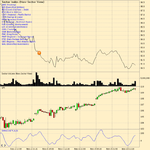Gob00st
Member
- Messages
- 74
- Likes
- 2
Hi Charlton,
Thanks for the explanation 👍
But is this the common practise to choose day-trading stocks by filtering them from swing trading candidates ? If not, what is the common practise to choose day-trading stocks?
Regards,
Albert
Thanks for the explanation 👍
But is this the common practise to choose day-trading stocks by filtering them from swing trading candidates ? If not, what is the common practise to choose day-trading stocks?
Regards,
Albert
They would be good candidates for swing trading, but equally you could feed them into your radar screen containing the Iraj N min change and a row for $INDU. Their relative strength, as I explained in an earlier post, would show how they are currently performing during the current session and hence you would be sorting them into a few potential candidates for daytrading
It's not an exact science so it is best to try it out on a SIM account first to see how the stronger and weaker stocks move compared to market movement,
What you are doing is reducing risk by lining up more things in your favour.
Charlton

